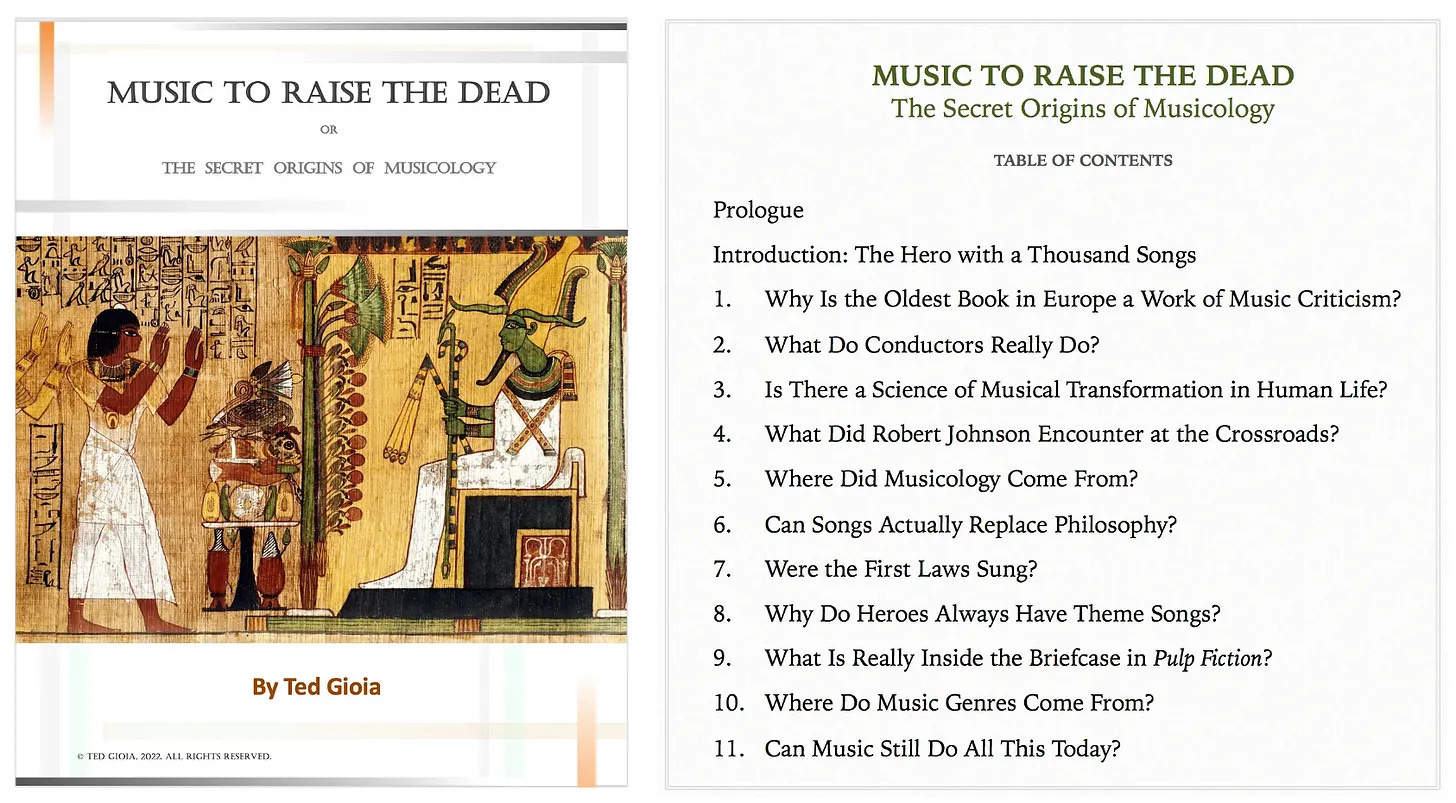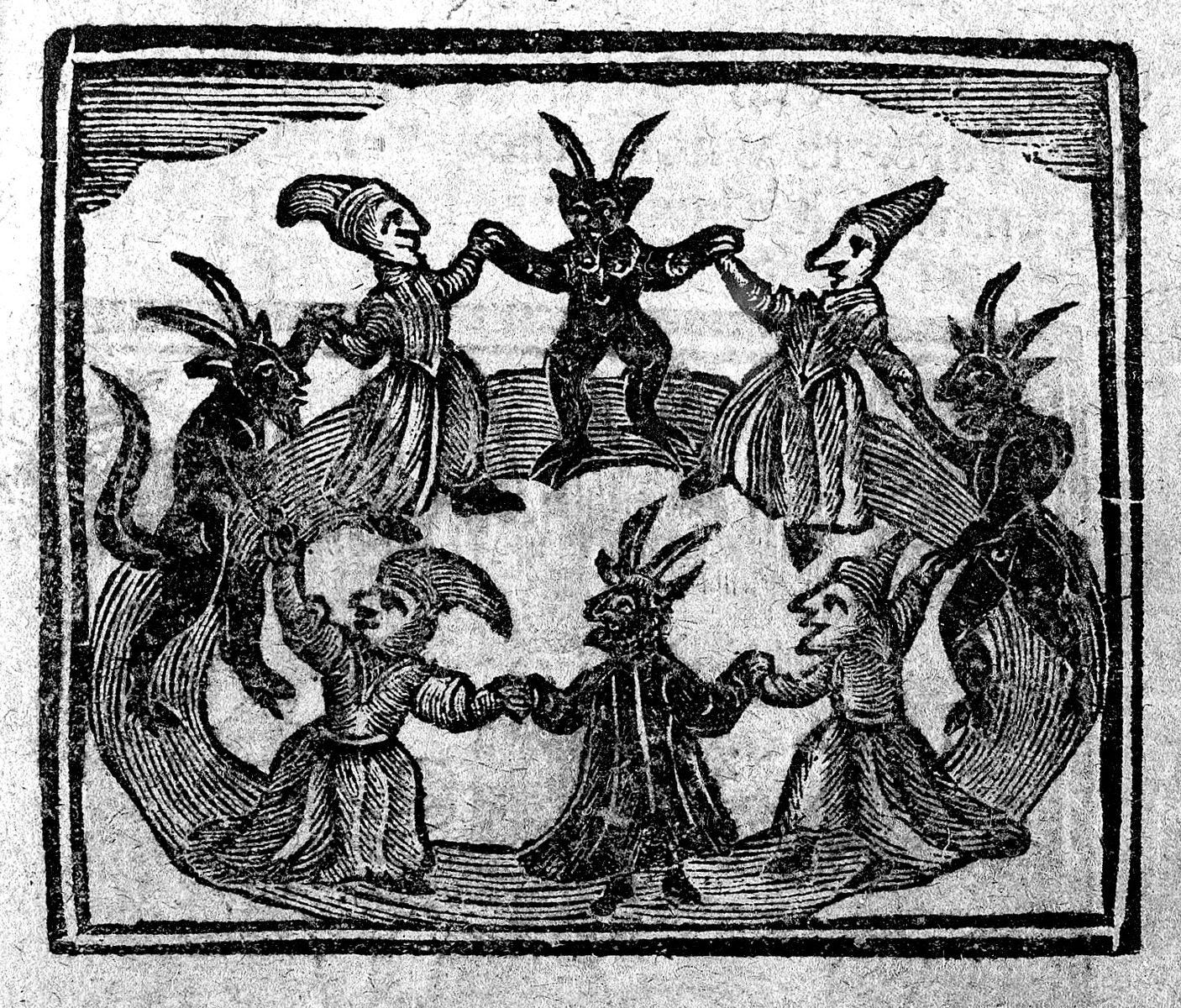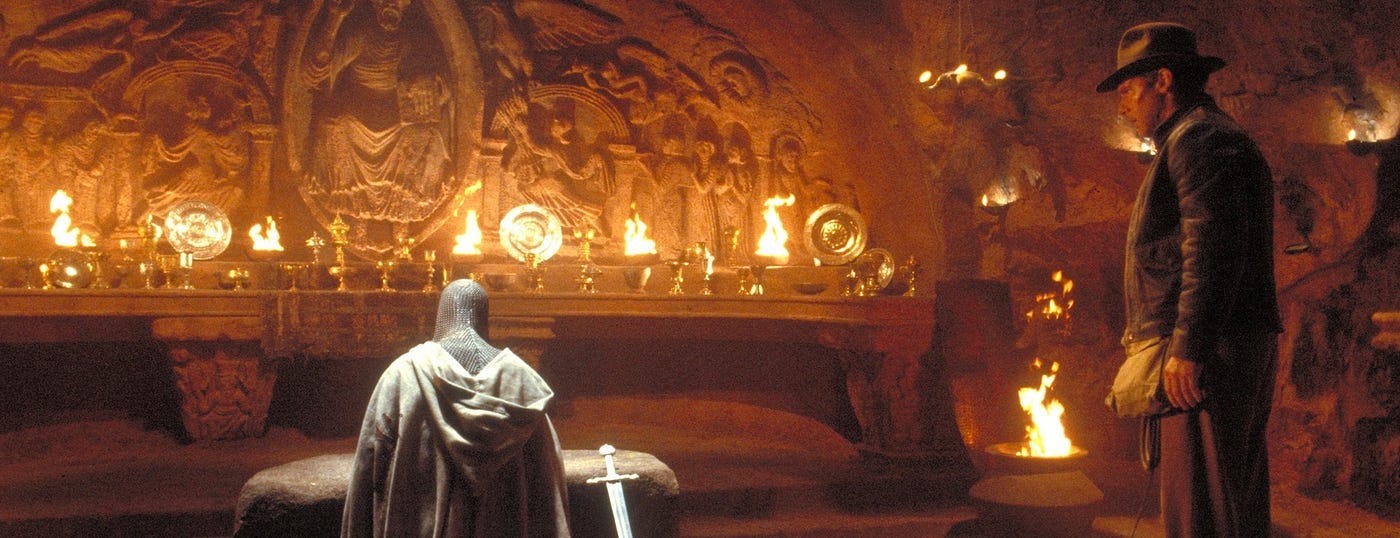How Secret Practices of Magical Musicians Survived Into the Modern WorldA new installment of my online book 'Music to Raise the Dead'Below is a section from my online book Music to Raise the Dead. This book is currently available only on Substack. I publish new installments every month, more or less. You can read individual sections as stand-alone essays—or sequentially as part of a unified book. All of the chapters published so far can be read for free. (But the entire book may go behind the paywall in the future.) The Honest Broker is a reader-supported guide to music, books, and culture. Both free and paid subscriptions are available. If you want to support my work, the best way is by taking out a paid subscription.Here are links to all of the chapters currently available: MUSIC TO RAISE THE DEAD: The Secret Origins of MusicologyTable of ContentsPrologue
Today I show how an ancient tradition of musical heroes somehow survived into modern times. I’ve already demonstrated how the mythos of blues musician Robert Johnson can only be understood in the context of this tradition. On the other extreme, I’ve explored how modern neuroscience validates this same ancient worldview. Below I share the results of my detective work—disclosing how mysterious musical practices have survived continuously, over the course of thousands of years, although hidden from view—unknown even to music historians and musicologists. What Is Really Inside the Briefcase in Pulp Fiction? (Part 2 of 2)In her book From Ritual to Romance (1920), Jessie Weston kept offering hints of a secret organization she had discovered during her research into ancient fertility rites and myths relating to King Arthur. She refused to reveal sources or offer many details, but her claims were nonetheless extraordinary. She tells us that the hero’s journey to another world isn’t just a myth or legend, but a vibrant practice—and it still exists, Weston insists, although participants are sworn to secrecy. Could this possibly be true? Is there a secret organization of magical singers still operating in modern society, with roots going back to ancient pagan rituals? That’s hard to believe, but… But Jessie Weston had no idea what would happen just one year after she published her work. Margaret Alice Murray released a scandalous book, The Witch Cult in Western Europe, which documented how fertility rituals infused with music and dance had survived for centuries in the midst of Christian societies. Not only hadn’t the old pagan religion disappeared, but it actually retained a significant number of practitioners and believers all over Western Europe. The reason why scholars hadn’t recognized this was because the authorities had treated this music-and-dance cult as witchcraft. But, according to Murray, this was a distortion imposed by the ruling class, and a return to original source documents would prove this. Murray was widely attacked, and for years her views were treated with disdain by academics. But in 1966, historian Carlo Ginzburg released dramatic findings drawn from his archival research. These included verbatim testimonies from some of the earliest witch trials in Europe. Here the accused insisted they were not witches, but benandanti—which translates as people who go on journeys to do good deeds. That’s uncannily similar to the view of musical heroism that forms the subject of this entire book, and specifically to the stories of the Holy Grail we’re discussing now. The details Ginzburg shares of this cult also recall musical rituals we have studied in previous pages—except that during the 16th and 17th centuries these activities were now considered witchcraft. When you danced to this music, you were literally dancing with the devil, or so the authorities claimed—although participants often insisted otherwise. But those denials had no effect. So this was dangerous music. You could be executed for participating in such revelries.
Here’s what the benandanti actually claimed under interrogation
Just stop and consider how uncanny this is. At the very start of the infamous witch trials, the accused were practicing an alternative musicology identical to the ancient (or even prehistoric) conceptual system we’re outlining in this book. But with one big difference—these ‘heroes’ were now branded as witches, and executed for their ‘good deeds’. Ginzburg continued to study this subject for decades, and eventually published a follow-up book Ecstasies in 1989—where he traced the origins of European and American witchcraft back to the shamanistic belief systems that undergird the heroic conception of musicology presented in these pages. When forced to sum up this wide and deep sweep of events and creeds, Ginzburg pinpointed its epicenter. But this came only after he had studied this movement in all its manifestations—including “Lap or Siberian shamans, the Baltic werewolves, the armiers of the Pyrenean Ariége, the benandanti of Friuli, Dalmatian kresniki, the Romanian câluşari, the Hungarian táltos, the Caucasian burkudzäutä” and other groups. What did they have in common? In the words of Carlo Ginzburg: “the primary nucleus consists in the journey of the living into the realm of the dead.” That’s exactly the same thing I found in my studies of the hidden origins of musicology—although I was unaware of Ginzburg’s witchcraft testimonies until fairly late in my own research, and came to the same endpoint independently of him. But I have pushed these inquiries into matters he never considered. For example, I have expanded the scope of Ginzburg’s research to include a host of previously unnoticed musical manifestations, ranging from blues legend Robert Johnson’s crossroads encounter to the role of dreams in the composition of an uncanny number of hit songs. Each of these scholars has been criticized by later academics—although more often simply ignored. But their views have never been refuted. And in the case of Jessie Weston’s reluctance to offer specific details of mysterious 20th century rituals, her silence is very much in keeping with the entire history of these belief systems, which are built on frustratingly vague descriptions—almost as if the authors were unwilling to tell us the whole story. But they were probably sworn to secrecy as part of their initiation. And after the witch trials and executions, can you blame them for keeping their rituals and beliefs hidden from view? This musicology may be powerful knowledge, but it’s also dangerous knowledge. That’s the same problem medieval bards faced more than a thousand years ago. They were preserving heretical pagan wisdom—and this put their lives at risk. And that’s why the Grail legend is so confusing. In fact, you can’t even figure out what a Grail is from the early versions of the story. You have probably heard that it is the cup used by Jesus at the Last Supper, but that’s hardly clear from the oldest documents. In these, the san graal is a revered object that might be a large jeweled serving dish. Or it may be a cup used by Joseph of Arimathea, who buried Christ after the crucifixion, to collect his blood. Or, adding to the mystery, the words san graal (holy grail) could easily be heard as sang real (or royal blood). So take your pick. But those are hardly our only options. When the Grail story was adopted by Wolfram von Eschenbach for his 13th century poem Parzival, the object is now a magical stone. Or consider the claim that the Grail is really a miraculous cauldron that produces an abundant quantity of food for those blessed enough to be in its presence—a hypothesis supported by many old texts. On the other extreme, a stone container found in 1920 on the grounds of Hawkstone Hall, a British country house in Shropshire, and promoted as the real-life Holy Grail probably does date back to the time of Christ, but is much smaller than a cauldron and most likely originated as a Roman makeup pot. And that’s far from the only Holy Grail in Britain: many people in Rhydyfelin, near Aberystwyth in Wales, believe that it is a wooden bowl, allegedly made from the True Cross, which (they say) heals those who drink from it. And others have speculated that the Grail isn’t an object at all, but a person—a descendant of Jesus Christ and his wife Mary Magdalene—an alternative view much prized by conspiracy theorists and popularized by Dan Brown’s best-selling novel The Da Vinci Code. But we also need to consider the possibility that the Grail is a location, a building or sacred site, or (according to some) all of Wales in its entirety. Yet as soon as you view the Grail tradition in the context of the larger hero’s quest, it’s clear that this confusion exists for a good reason. And it’s the same reason why the specific details of a MacGuffin are rarely spelled out in movies, and are reduced to the glow from a briefcase in Pulp Fiction, or vague “government secrets” in North by Northwest. In other words, no physical object can live up to the awe and reverence attributed to the Grail. Perhaps, as I suggested above, storytellers who perpetuated this tale were under some vow of secrecy, and couldn’t describe the Grail for that reason. But even if they weren’t under a prohibition, they still had a motive to disclose as little as possible. Doing more would spoil a good story. For this reason, we should stop trying to describe what the Grail is, and focus more on what it does. Here the tradition is much clearer, and extremely relevant to the matters under examination in this book. The Grail, whether stone, cup, or some other object, has the power to sustain and heal. In some instances, it can even bring the dying or dead back to life. And now we are on familiar grounds, face-to-face with a tradition congruent with what we have found in the myth of Orpheus, the shamanism of North Asia, the vision quests of Native American traditions, and other sources. For this reason, we are perhaps best served by listening to those more mystical commentators, such as A.E. Waite, Emma Jung, and Rudolf Steiner, among others—who are happy to put all relics aside and embrace the Holy Grail as a powerful personal experience. The size and shape of the physical object are irrelevant, but what it does to you is decisive and life-changing. Just like music. For this reason, my favorite cinematic treatment of the MacGuffin comes at the conclusion of Indiana Jones and the Last Crusade. In this installment of the franchise, archeologist Indiana Jones, famous seeker of lost relics, is reunited with his father Henry Jones, Sr., a medievalist who was an indifferent dad—because he was more interested in the Holy Grail than raising his son. After the usual chases, fights, and adventures, the duo find the actual temple where the Grail is kept safe, protected by three booby traps. But in the process of navigating through these dangers, Henry Jones is mortally wounded—and now his son must find the sacred relic, not just for its historical value but to save his father’s life. In an extraordinary scene, he comes to the inner sanctum where the Grail has been guarded by an Arthurian knight, kept alive for centuries by the sustaining power of the divine object he protects. The real Grail is here in this chamber, but it is surrounded by many cups, chalices, and platters of various shapes and designs—and a wrong choice brings certain death. Our savvy archeologist ignores all of the glittering options, and picks the humblest vessel of them all, remarking: “That’s the cup of a carpenter.” “You have chosen wisely,” the knight responds. Jones has picked the true Grail among all the fakes ones—and thus saves the life of his father. I especially relish the symbolic value here. Sean Connery, who plays Henry Jones in this film, was the actor who turned James Bond into the prototype of all later movie hero franchises—including the Indiana Jones movies and spin-offs—with all their assorted MacGuffins. He is very much their father (at least on a symbolic level) as well as an actual dad here on the silver screen. So it’s quite appropriate that, in this glorious scene, he is sustained by the Holy Grail itself, and in a guise so lowly that nobody would value it highly if it were only a physical object. How fitting that, after a thousand years, the Grail is still important for its transformative capacities. It can even bring a quest hero back from the realm of the dead. As we trace the history of this quest back to its origins, we find that the Grail achieves as a physical object what songs did for the author of the Derveni papyrus. When Orpheus brought a soul back from the dead, he used music. When Indiana Jones did the same, he needed a cup. So it’s hardly an exaggeration to claim that the MacGuffin objectifies the magic once held by powerful songs. Hence, if you ask me about the glowing object inside the briefcase in Pulp Fiction—which leads various protagonists to risk their lives, and propels a manic plot forward for 154 minutes—I can’t give you any physical details. But I can tell you what it wants to be. It aspires to be a song. But not just an ordinary song—a special one of extraordinary capacities. Maybe filmmaker Quentin Tarantino didn’t explicitly understand this, but it’s implicit in the tradition that gave birth to the MacGuffin. We have many words to describe intangible things related to the human condition that get treated as objects.
Yet no matter what term you use, the underlying situation is the same: Something vital and intangible gets transmuted, through a reductive alchemy, into a thing. And the thing hides it origins, misleading those who are mesmerized by its concreteness and presence. That’s the history of musicology, in a nutshell. This musical tradition has now resulted in thousands of stories about heroic journeys. The details are different but the underlying significance is the same. As Northrop Frye has pointed out, the hero in a traditional quest slays the dragon as a symbolic triumph over evil. The external adventure is merely a stand-in for a victory that is implicitly personal or spiritual in nature. He explains:
The prominence of personal rebirth in these stories could hardly be clearer—the victim is literally resurrected from the monster. At this stage, the hero’s story is clearly linked with regeneration, often the revitalization of a mythical waste land or its wounded king, or (at a minimum) the rescue of the hero’s spouse. But consider the gradual steps by which this pristine story is degraded, In later versions the dragon is portrayed as guarding a hoard of gold, and this is a significant step down in the hierarchy of vision quests. The crass monetary reward demeans the hero’s quest, but always makes it a more suitable formula for narrative in an age of commerce and profit-making. In the next phase, the dragon disappears completely and the battle is merely about the gold, as in the classic Hollywood movie The Treasure of Sierra Madre (1948). In its final state, even the gold disappears, with only its glow left, emanating from the briefcase in Pulp Fiction. I note, however, that the combination that opens the briefcase lock in this film is 666—the Number of the Beast. So even in Pulp Fiction, a symbolic dragon gets slayed or unlocked. Before proceeding, let’s summarize what we’ve learned in this chapter. (1) The modern hero’s journey, as celebrated in movies and other media, has replaced the metaphysical goal of the quest with a physical object. This undermines the most essential ingredient of the journey, but makes the story more suitable for mass entertainment. (2) Those who conduct this hero’s journey possess powerful knowledge—but it is also dangerous knowledge. This alternative musicology eventually got attacked as witchcraft. For centuries, people who openly practiced these techniques put their lives at risk. (3) But these same techniques got Christianized in the legend of the Holy Grail, which stands out as the most famous object in the history of heroic quests. In the early versions of the Arthurian legend, the Grail played a comparatively minor role, and was described with such vagueness that it wasn’t even clear what it was—a cup, a platter, a cauldron, perhaps some other object, or merely a symbol. But when the Arthurian stories got turned into profit-making books, most notably with Le Morte d'Arthur, this object gained prominence as a central focus of the narratives. (4) The modern equivalent of the Holy Grail is the MacGuffin, a device used by filmmakers to propel an adventure story, but whose specific details are largely irrelevant to the plot. “The main thing I’ve learned over the years,” Alfred Hitchcock insisted, “is that the MacGuffin is nothing.” (5) In its final stage of development, the MacGuffin can be as non-descript as a glowing light from an unseen object—as with the briefcase in Pulp Fiction. But this transformation is driven as much by necessity as cinematic creativity. No physical object can plausibly serve as a stand-in for the rebirth and transformation promised by the traditional hero’s quest. Hence, filmmakers (or video game developers or other constructors of narratives) are wise to treat these stand-ins with an attitude of reticence or even outright secrecy. (6) In traditional quests—such as those pursued by the Native American dream seekers or Robert Johnson in the tale of the crossroads—the resulting transformation can be represented, in whole or part, by a song. When viewed in this context, we ought to view these various MacGuffins as hypostatized or reified music. The song—or the wisdom it contains or represents—is made concrete, but in a way that masks its origins, although making the whole narrative more suitable for generating commerce and building brand franchises. Notes: Margaret Alice Murray: Margaret Alice Murray: The Witch Cult in Western Europe (Oxford: Clarendon Press, 1921). Lap or Siberian shamans, the Baltic werewolves: This and below from Carlo Ginzburg, Ecstasies: Deciphering the Witches Sabbath, translated by Raymond Rosenthal (Chicago: University of Chicago Press, 1991), p. 23. In the folk tale versions of the dragon killing stories: Northrop Frye, Anatomy of Criticism: Four Essays (Princeton: Princeton University Press, 1971), p. 190. Consider other related stories of regurgitating monsters, such as the tale of Jonah and whale from the Bible, as part of this same lineage. The Orphic tradition, central to the hero’s journey as outlined in this book, put great emphasis on the myth of Dionysus’s dismemberment by the Titans, and resurrection by Zeus as a symbol of regeneration and purification. You're currently a free subscriber to The Honest Broker. For the full experience, upgrade your subscription. |
Search thousands of free JavaScript snippets that you can quickly copy and paste into your web pages. Get free JavaScript tutorials, references, code, menus, calendars, popup windows, games, and much more.
How Secret Practices of Magical Musicians Survived Into the Modern World
Subscribe to:
Post Comments (Atom)
I Quit AeroMedLab
Watch now (2 mins) | Today is my last day at AeroMedLab ͏ ͏ ͏ ͏ ͏ ͏ ͏ ͏ ͏ ͏ ͏ ͏ ...
-
code.gs // 1. Enter sheet name where data is to be written below var SHEET_NAME = "Sheet1" ; // 2. Run > setup // // 3....




No comments:
Post a Comment